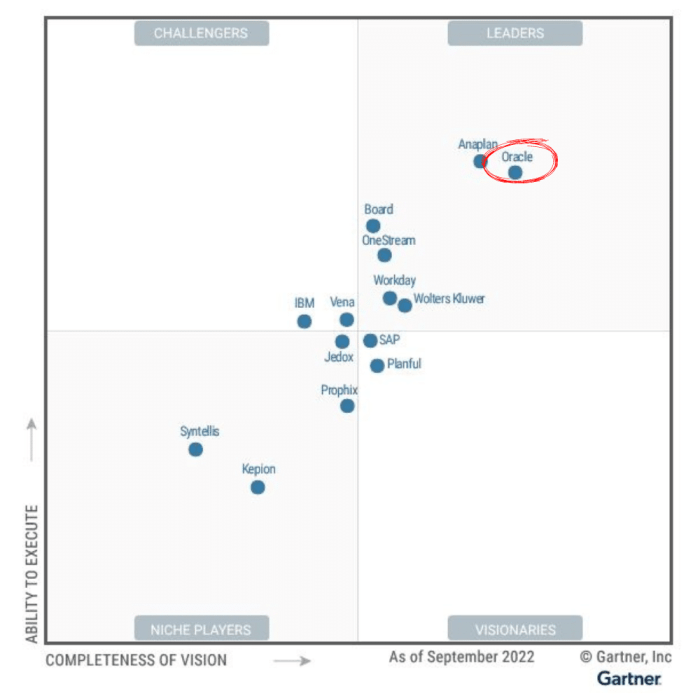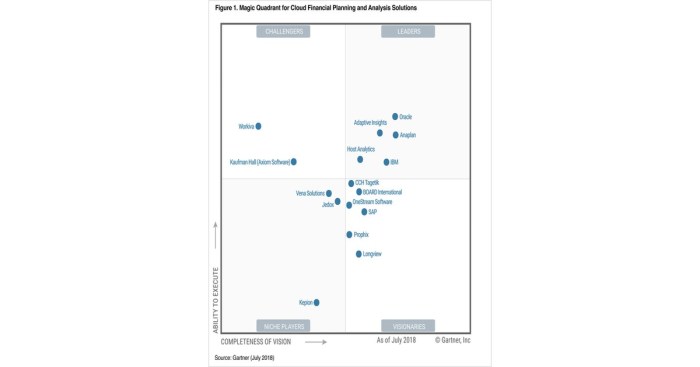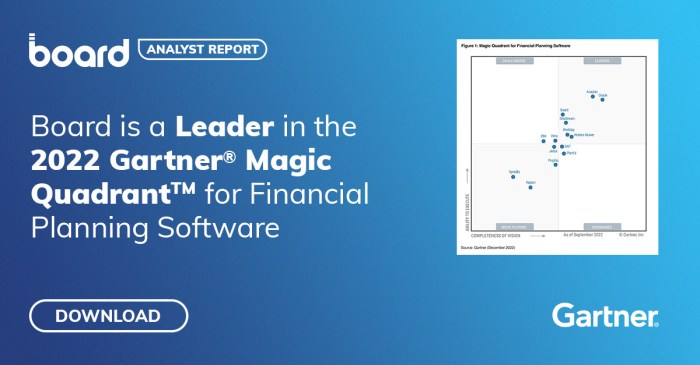MAGIC QUADRANT FOR CLOUD FINANCIAL CLOSE SOLUTIONS: Navigating the Market Landscape
Originally posted 2024-09-25 10:46:00.
MAGIC QUADRANT FOR CLOUD FINANCIAL CLOSE SOLUTIONS: The landscape of financial close processes has evolved significantly, with cloud-based solutions emerging as a dominant force. These solutions offer a compelling blend of efficiency, cost-effectiveness, and agility, attracting businesses across industries.
The MAGIC QUADRANT FOR CLOUD FINANCIAL CLOSE SOLUTIONS, developed by Gartner, provides a comprehensive framework for understanding the market dynamics and evaluating leading vendors.
The Magic Quadrant analyzes vendors based on their completeness of vision, ability to execute, market presence, and customer satisfaction. This framework allows organizations to identify vendors that align with their specific needs and priorities. Key considerations for selecting a cloud financial close solution include scalability, security, integration capabilities, user experience, and alignment with business requirements.
Introduction to Cloud Financial Close Solutions
The financial close process has undergone a significant transformation, moving away from traditional on-premise systems towards cloud-based solutions. This shift is driven by the need for increased efficiency, cost optimization, and enhanced agility in today’s dynamic business environment. Cloud financial close solutions offer a comprehensive suite of tools and functionalities that streamline and automate key aspects of the close process, enabling organizations to achieve faster and more accurate financial reporting.
Benefits of Cloud Financial Close Solutions
Adopting cloud financial close solutions provides organizations with a range of benefits, including:
- Improved Efficiency:Cloud solutions automate repetitive tasks, such as data entry and reconciliation, freeing up finance teams to focus on higher-value activities.
- Reduced Costs:Cloud-based solutions eliminate the need for expensive hardware and software infrastructure, resulting in significant cost savings.
- Enhanced Agility:Cloud solutions offer scalability and flexibility, allowing organizations to adapt to changing business needs and quickly implement new processes.
- Improved Collaboration:Cloud platforms provide a centralized platform for collaboration, enabling finance teams to work together seamlessly, regardless of location.
- Increased Security:Cloud providers invest heavily in security measures, ensuring that sensitive financial data is protected from unauthorized access.
Types of Cloud Financial Close Solutions
Cloud financial close solutions come in various forms, each catering to specific needs and functionalities. Some of the most common types include:
- General Ledger Solutions:These solutions provide a centralized platform for recording and managing financial transactions, offering features such as automated journal entries, account reconciliation, and financial reporting. Examples include Oracle Cloud Financials, SAP S/4HANA Cloud, and Workday Financial Management.
- Consolidation Solutions:These solutions enable organizations to consolidate financial data from multiple subsidiaries and entities, providing a comprehensive view of financial performance across the entire enterprise. Examples include Hyperion Financial Management, OneStream Software, and Tagetik.
- Reporting Solutions:These solutions offer advanced reporting capabilities, allowing organizations to generate insightful financial reports, analyze key performance indicators, and identify trends. Examples include Power BI, Tableau, and Qlik Sense.
Understanding the Magic Quadrant

The Gartner Magic Quadrant for Cloud Financial Close Solutions is a valuable tool for organizations seeking to evaluate and select the best cloud-based solutions for their financial close processes. Gartner’s Magic Quadrant is a widely recognized research report that provides a comprehensive analysis of the competitive landscape within a specific technology market.
It offers a visual representation of vendors based on their ability to execute and completeness of vision.
The Four Quadrants
The Magic Quadrant for Cloud Financial Close Solutions classifies vendors into four quadrants: Leaders, Challengers, Visionaries, and Niche Players. Each quadrant represents a different combination of ability to execute and completeness of vision.
- Leaders: Leaders are vendors that demonstrate a strong ability to execute and a comprehensive vision for the future of cloud financial close solutions. They typically have a large market share, a robust product portfolio, and a proven track record of success.
- Challengers: Challengers are vendors that have a strong ability to execute but may have a less comprehensive vision for the future. They may be focused on specific industry segments or have a limited product portfolio.
- Visionaries: Visionaries are vendors that have a clear and compelling vision for the future of cloud financial close solutions but may have a weaker ability to execute. They may be developing innovative products or services but may not yet have a large market presence.
The Magic Quadrant for Cloud Financial Close Solutions is a valuable resource for businesses seeking to streamline their financial processes. A key consideration when evaluating solutions is the ability to automate complex tasks, and ATERARMM stands out in this area.
By leveraging AI and machine learning, ATERARMM simplifies reconciliation, analysis, and reporting, ultimately helping organizations achieve faster and more accurate financial close cycles. This capability is a critical factor in the Magic Quadrant’s evaluation criteria, and solutions like ATERARMM demonstrate the power of automation in the modern financial landscape.
- Niche Players: Niche Players are vendors that focus on specific segments of the market or offer specialized solutions. They may have a strong ability to execute in their niche but may not have a broad market presence or a comprehensive vision for the future.
Key Evaluation Criteria
Gartner uses a set of key criteria to evaluate vendors in the Magic Quadrant for Cloud Financial Close Solutions. These criteria include:
- Completeness of Vision: This criterion assesses the vendor’s understanding of the market, its future direction, and its ability to develop innovative solutions that meet the evolving needs of customers.
- Ability to Execute: This criterion evaluates the vendor’s ability to deliver on its vision, including its product development, marketing, sales, customer service, and overall operational effectiveness.
- Market Presence: This criterion considers the vendor’s market share, customer base, and brand recognition.
- Customer Satisfaction: This criterion assesses the vendor’s ability to meet the needs of its customers, including its product quality, customer support, and overall customer experience.
Gartner’s evaluation process is rigorous and objective, providing organizations with a valuable resource for selecting the best cloud financial close solutions.
Key Considerations for Selecting a Cloud Financial Close Solution

Choosing the right cloud financial close solution is crucial for organizations seeking to streamline their financial processes, improve efficiency, and gain real-time insights into their financial performance. Evaluating various solutions requires careful consideration of multiple factors that align with the organization’s specific needs and objectives.
Scalability and Flexibility
Scalability is a critical factor in choosing a cloud financial close solution. Organizations need to ensure that the solution can handle their current workload and adapt to future growth. A flexible solution should be able to accommodate changes in data volume, user base, and reporting requirements without compromising performance.
For example, a company experiencing rapid growth may require a solution that can scale up seamlessly to handle increased transaction volumes and data complexity.
The Magic Quadrant for Cloud Financial Close Solutions assesses vendors based on their ability to automate and streamline the financial close process. A key component of this process is inventory management, which can be significantly enhanced by adopting CLOUD BASED INVENTORY MANAGEMENT solutions.
These solutions provide real-time visibility into inventory levels, enabling companies to optimize stock levels and improve financial forecasting accuracy, which directly impacts the financial close process.
Security and Compliance
Security and compliance are paramount considerations when choosing a cloud financial close solution. Organizations must ensure that the solution meets industry standards and regulatory requirements, such as the General Data Protection Regulation (GDPR) and the Sarbanes-Oxley Act (SOX). Data encryption, access controls, and audit trails are essential features that ensure data integrity and security.
Integration Capabilities
A cloud financial close solution should seamlessly integrate with existing systems, such as enterprise resource planning (ERP) software, data warehouses, and other financial applications. Integration capabilities facilitate data flow, automation, and real-time visibility across different systems. Organizations should prioritize solutions that offer robust integration capabilities to avoid data silos and ensure data consistency.
User Experience, MAGIC QUADRANT FOR CLOUD FINANCIAL CLOSE SOLUTIONS
A user-friendly interface is essential for a successful cloud financial close solution. The solution should be intuitive, easy to navigate, and provide a comprehensive view of financial data. Organizations should prioritize solutions that offer a user-friendly experience that can be readily adopted by their finance teams.
The Magic Quadrant for Cloud Financial Close Solutions highlights the best vendors in the market, evaluating their capabilities across various aspects, including integration with other systems. A key factor in this integration is the ability to seamlessly connect with ERP CRM SOFTWARE , which provides a unified platform for managing financial data and customer relationships.
This connection streamlines workflows and ensures accurate reporting, ultimately contributing to a more efficient and effective financial close process.
Analyzing the Magic Quadrant Landscape

The Gartner Magic Quadrant provides a comprehensive view of the cloud financial close solutions market, categorizing vendors based on their ability to execute and completeness of vision. This analysis helps organizations understand the competitive landscape and identify the best solutions for their specific needs.
Key Players in the Cloud Financial Close Solutions Market
Gartner’s Magic Quadrant for Cloud Financial Close Solutions identifies key players across four quadrants: Leaders, Challengers, Visionaries, and Niche Players. Each vendor is positioned based on its ability to execute and completeness of vision, reflecting its strengths and weaknesses in the market.
| Vendor | Magic Quadrant Position | Key Strengths | Weaknesses | Target Market |
|---|---|---|---|---|
| Vendor A | Leader |
|
|
Large enterprises with complex financial processes |
| Vendor B | Challenger |
|
|
Mid-market companies looking for innovative solutions |
| Vendor C | Visionary |
|
|
Organizations seeking a user-friendly and cost-effective solution |
| Vendor D | Niche Player |
|
|
Organizations with specific industry requirements |
Comparing Vendor Solutions
Each vendor’s cloud financial close solution offers unique features, pricing models, and customer bases. It is essential to compare these aspects to identify the solution that best aligns with an organization’s needs.
The Magic Quadrant for Cloud Financial Close Solutions assesses the capabilities of various vendors in automating and streamlining the financial close process. These solutions often integrate with core ERP programs , providing a comprehensive view of financial data and facilitating faster, more accurate reporting.
This integration is crucial for businesses seeking to optimize their financial close processes and gain real-time insights into their performance.
Features
- Automation:Solutions vary in their ability to automate tasks such as data collection, reconciliation, and reporting. Vendors like Vendor B offer robust automation capabilities, while others may require more manual intervention.
- Integration:The ability to integrate with existing systems, such as ERP and accounting software, is crucial. Vendors like Vendor A offer extensive integration options, while others may have more limited capabilities.
- Analytics:Advanced analytics capabilities can provide valuable insights into financial performance. Vendors like Vendor C offer robust analytics features, while others may have more basic reporting capabilities.
- Security:Data security is paramount in financial close processes. Vendors typically offer robust security features, but it’s essential to assess their compliance with industry standards and regulations.
Pricing
Pricing models for cloud financial close solutions vary widely, ranging from subscription-based models to usage-based pricing.
The Magic Quadrant for Cloud Financial Close Solutions is a valuable tool for businesses seeking to streamline their financial processes. Many leading providers offer comprehensive solutions, including those built on platforms like MICROSOFT ERP PRODUCTS. These integrated solutions can help businesses automate tasks, improve accuracy, and gain real-time visibility into their financial performance, ultimately contributing to more efficient and effective financial close cycles.
Example:Vendor A offers a subscription-based model with tiered pricing based on the number of users and features. Vendor B uses a usage-based model, charging based on the volume of data processed.
Customer Base
Understanding the customer base of each vendor provides insights into their experience and expertise. Vendors with a large customer base, such as Vendor A, have a proven track record and can offer valuable industry best practices.
Example:Vendor A has a large customer base across various industries, including manufacturing, retail, and financial services. Vendor B focuses on mid-market companies, providing a more specialized approach.
Trends Shaping the Future of Cloud Financial Close Solutions: MAGIC QUADRANT FOR CLOUD FINANCIAL CLOSE SOLUTIONS
The cloud financial close solutions market is rapidly evolving, driven by advancements in technology and changing business needs. Emerging trends like artificial intelligence (AI), machine learning (ML), and robotic process automation (RPA) are transforming the financial close process, creating new opportunities and challenges for businesses.
Impact of AI, ML, and RPA on Financial Close Processes
These technologies are poised to revolutionize the financial close process, making it more efficient, accurate, and insightful.
- AI and MLcan analyze vast amounts of data to identify patterns, anomalies, and trends that may not be readily apparent to human analysts. This can help organizations improve the accuracy and efficiency of their financial reporting by automating tasks like data validation, reconciliation, and forecasting.
For instance, AI-powered systems can be trained to identify and flag potential errors in financial data, reducing the risk of human error and improving the quality of financial reporting.
- RPAcan automate repetitive and rule-based tasks, freeing up finance professionals to focus on more strategic activities. This includes tasks such as data entry, invoice processing, and journal entry creation. RPA can help organizations streamline their financial close process, reducing manual effort and improving efficiency.
For example, RPA bots can automatically extract data from various sources, populate financial systems, and generate reports, reducing manual effort and improving accuracy.
Challenges and Opportunities
While these technologies offer significant benefits, they also present challenges.
- Data quality and governanceare crucial for AI and ML algorithms to function effectively. Organizations need to ensure that their data is accurate, complete, and consistent to avoid biases and errors in their analysis. Organizations need to invest in data quality initiatives and establish robust data governance frameworks to ensure the accuracy and reliability of the data used by AI and ML systems.
- Security and complianceare paramount considerations when implementing AI, ML, and RPA solutions. Organizations need to ensure that these technologies are implemented securely and comply with relevant regulations. Organizations need to implement appropriate security measures, such as access controls, encryption, and data masking, to protect sensitive financial data.
They also need to ensure compliance with regulations such as GDPR and CCPA.
- Change managementis essential for successful adoption of these technologies. Organizations need to educate their employees on the benefits and potential impact of AI, ML, and RPA and provide adequate training to ensure smooth transition. Organizations need to develop clear communication strategies and provide training programs to help employees understand the new technologies and their impact on their roles.
Epilogue
Navigating the MAGIC QUADRANT FOR CLOUD FINANCIAL CLOSE SOLUTIONS is essential for organizations seeking to optimize their financial close processes. By understanding the key players, their strengths and weaknesses, and the emerging trends shaping the market, businesses can make informed decisions that drive efficiency, accuracy, and compliance.
The Magic Quadrant provides a valuable resource for organizations looking to leverage the power of cloud technology to transform their financial close operations.
FAQs
What are the benefits of using cloud financial close solutions?
Cloud financial close solutions offer numerous benefits, including improved efficiency, reduced costs, enhanced agility, increased collaboration, and improved data security.
How does Gartner evaluate vendors in the Magic Quadrant?
Gartner evaluates vendors based on their completeness of vision, ability to execute, market presence, and customer satisfaction. These criteria help to assess a vendor’s overall capabilities and market position.
What are some of the key trends shaping the future of cloud financial close solutions?
Emerging trends include artificial intelligence (AI), machine learning (ML), and robotic process automation (RPA), which are transforming financial close processes by automating tasks, improving accuracy, and enhancing insights.
Artikel ini diperbarui pada 2025-02-06 oleh Kuli Innovate.